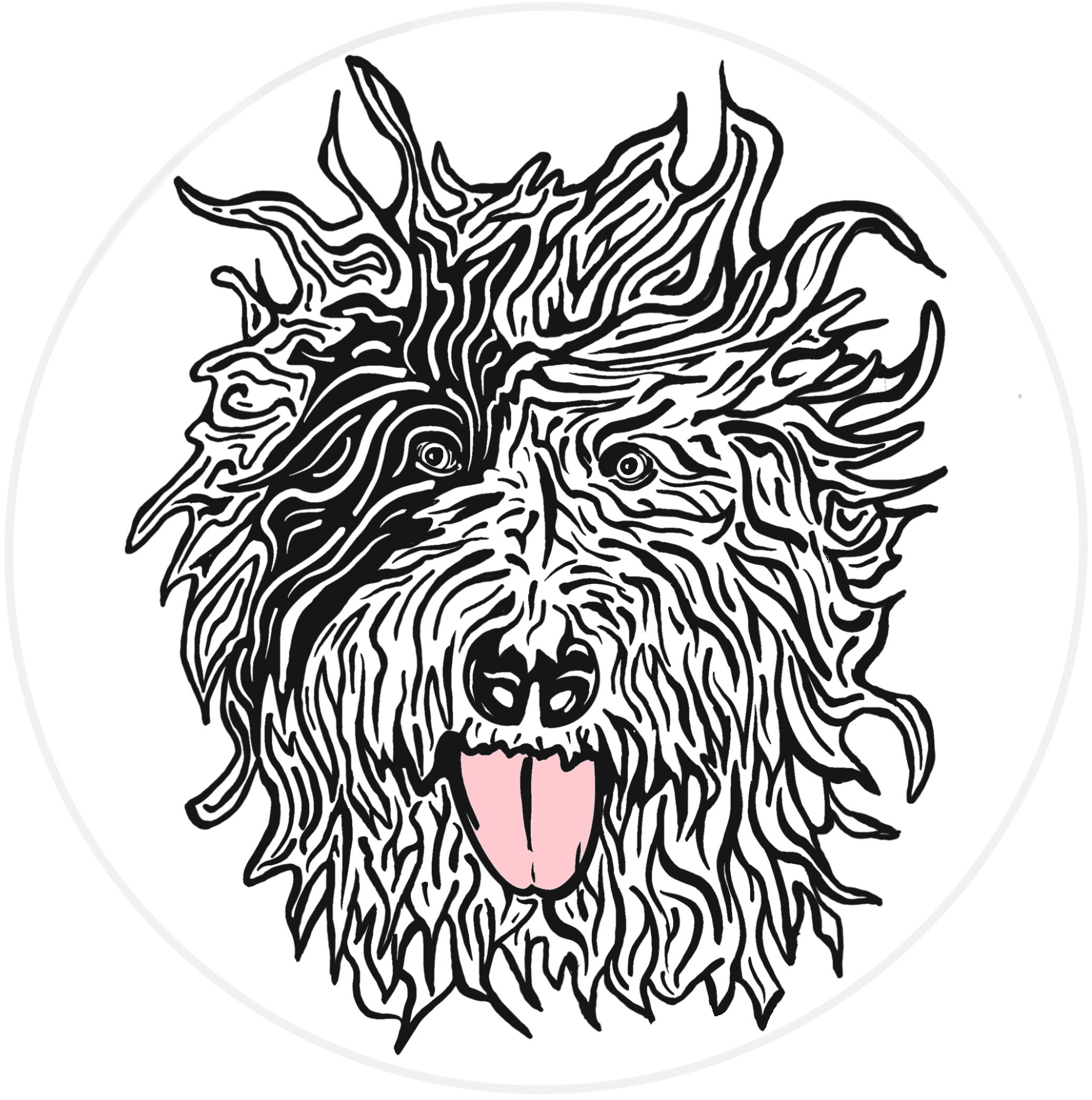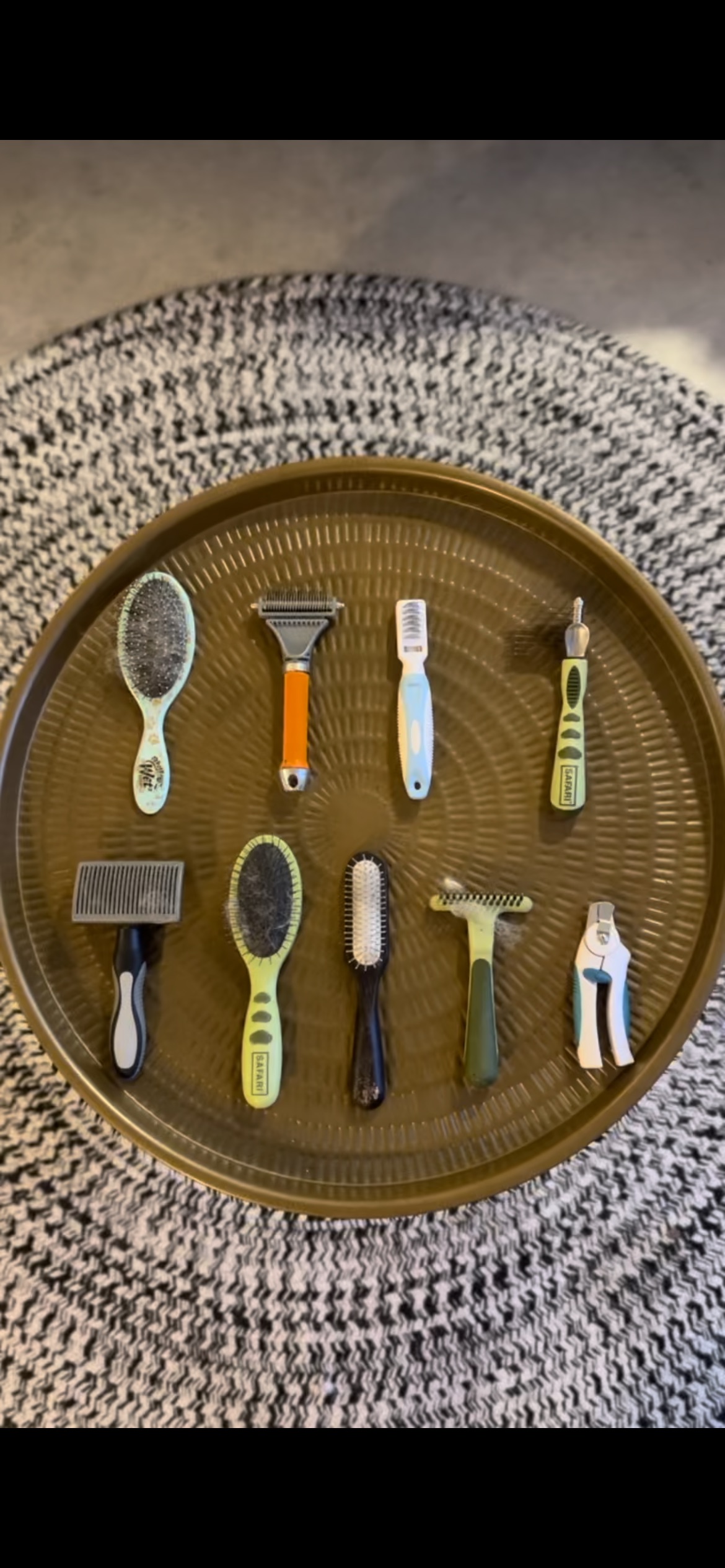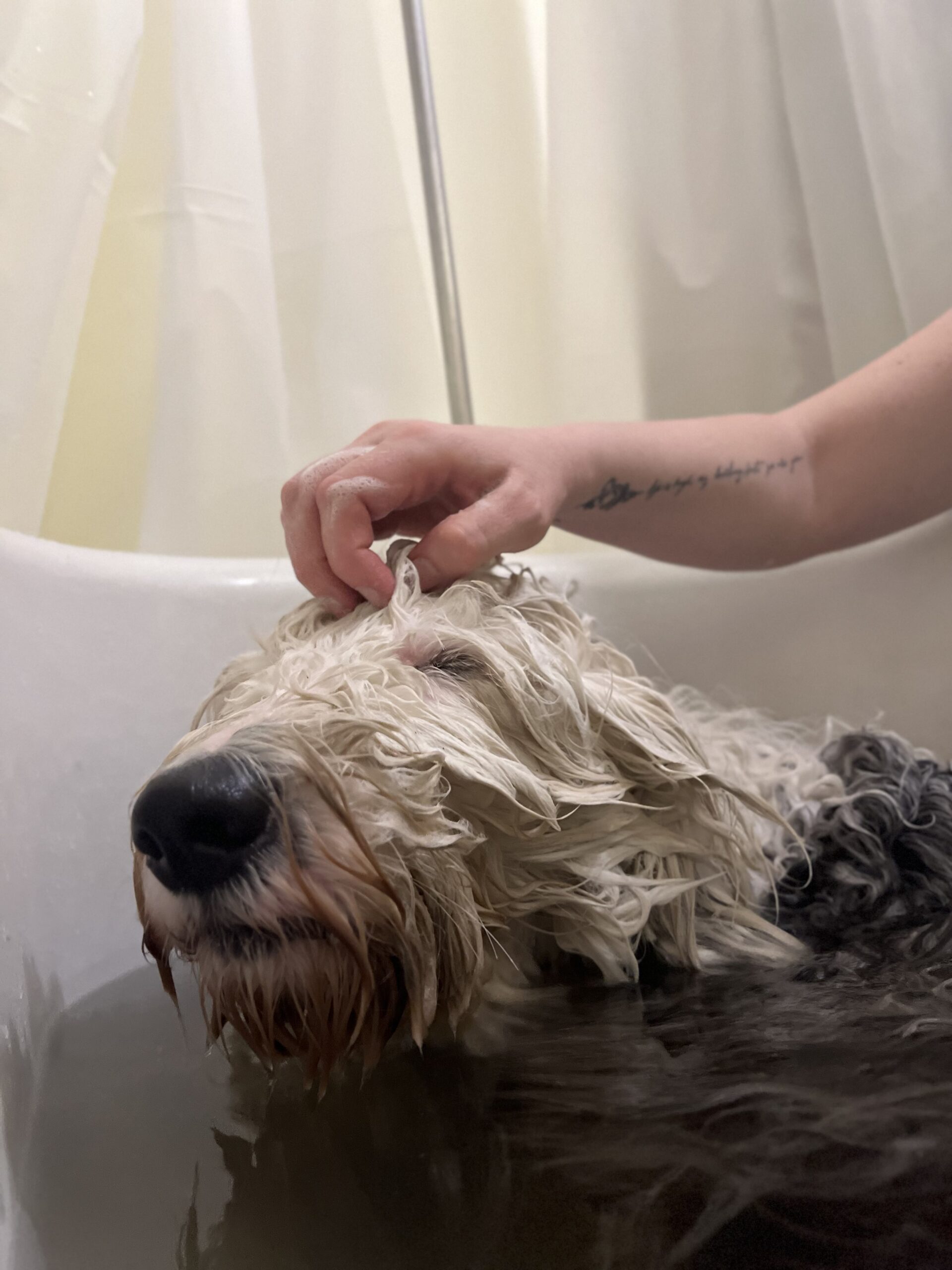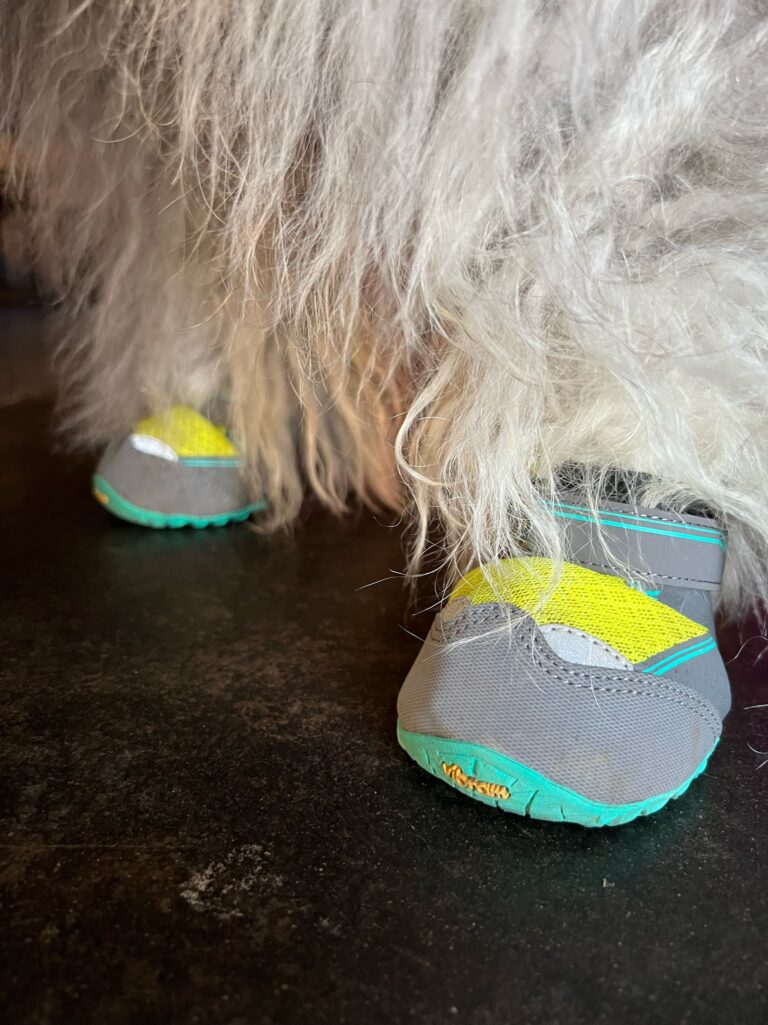Everyday Coat Maintenance:
Start with a slicker brush to remove loose fur and tangles. Follow up with a pin brush to reach the undercoat, ensuring thorough coverage. Pay special attention to the legs, belly, and tail, which can often hide mats. Finish with a wide-toothed comb to detangle any remaining knots. This routine should be part of your daily grooming ritual to prevent mat formation.
Mat Prevention:
To prevent mats from forming in the dense undercoat, use a pin brush to reach deep and gently separate the hair. Work systematically through the entire coat, ensuring that the undercoat is well-maintained. Pay attention to areas where mats tend to develop, such as behind the ears and under the collar. This preventive measure is especially important for your Sheepdog’s comfort and coat health.
Mat Removal:
If mats do develop, it’s essential to address them promptly to prevent discomfort and maintain your dog’s coat health. Here’s a step-by-step guide:
a. Assess the Mat: Examine the mat to determine its size and severity. Smaller mats near the surface are easier to tackle.
b. Use a Mat Splitter or Breaker: Begin by using a mat splitter or breaker to divide the mat into smaller sections. This process makes it easier to work through the tangles.
c. Apply Detangling Spray: Apply a detangling spray to the mat and allow it to sit for a few minutes. This will soften the hair and make it more pliable.
d. Use a Wide-Toothed Comb: Start by gently combing through the edges of the mat, working your way toward the center. Be patient and gentle to avoid causing pain. If the mat is extensive, divide it into smaller sections and tackle them one by one.
e. Follow Up with a Pin Brush: After using the comb, follow up with a pin brush to ensure the hair is well-groomed and to smooth out any remaining tangles
Bathing your beloved Old English Sheepdog (OES)

Here’s a gentle step-by-step guide to ensure a pleasant bathing experience for your furry companion:
- Timing Matters: Never bathe a matted dog. Bathing should only occur when your OES is genuinely dirty. At The Great White Fluffalo, we have a practice of bathing the entire coat during puppyhood. As your dog matures and develops an adult coat, full-body baths are reserved for when the coat appears visibly dirty, losing its natural luster and cleanliness.
- Choosing the Right Shampoo: For show purposes, we typically use a very dilute shampoo, focusing on cleaning the white areas and private parts only. Soap residue is a common culprit for skin problems, so we emphasize using a minimal amount. In cases of damaged coats, we sometimes condition the coat while brushing before the bath. Adding conditioner to the shampoo or using a cream rinse post-shampoo can also be beneficial.
- Thorough Rinsing: Prioritize thorough rinsing to eliminate all traces of shampoo from your dog’s coat. Begin by cleaning the dog’s ears to remove any ear cleaner and residue. Place cotton balls in the ear canal to prevent water entry. For dogs with sensitive eyes, consider using eye drops recommended by your veterinarian.
- Special Attention for Males: If you have a male OES, douche the sheath gently in the tub. Consult your vet for the appropriate solution. Insert the syringe into the sheath and dispense the liquid while gently manipulating the sheath to ensure even distribution. Rinse it out completely before proceeding with shampooing, conditioning if necessary, and thorough rinsing.
- Post-Bath Drying Ritual: After bathing, allow your dog to drip dry on towels for approximately 10 minutes. During this time, you can warm large bath towels in the dryer, creating a cozy and efficient drying environment. A chamois can also be used to absorb excess moisture. Follow up with a cool, no-heat dryer to remove additional moisture, taking care not to tangle the coat by holding the nozzle too closely.
- The Art of Drying: Transfer your dog to a table covered with towels and begin the drying process. Remove the cotton ear plugs if your dog objects to them. If your dog has a dry coat condition, consider using a conditioner spray as you dry, especially if using a dryer with a heating element. Ensure that the dryer operates without heat or uses very low heat to prevent hair breakage and brittleness. Gently pull the hair straight as you dry, allowing the air to blow away moisture effectively.
- Patience Is Key: Take your time and work methodically, moving in a circular pattern starting with the head. Use the dryer in sections, focusing on the head, neck, chest, rump, legs, body, and back. Gently pull the hair straight to maximize coat length. Avoid rushing through the process, as natural drying can sometimes leave the coat looking less than ideal.
- Finishing Touch: Finally, consider putting your dog’s hair up in a topknot to help them see clearly with their freshly groomed coat. You can secure it with a barrette, rubber band, or even create playful styles like devil horns or braids. Ensure the chosen method allows your dog to close its eyes comfortably. Not too loose, not too tight, just right!
A gentle Approach to Grooming at the Show
Grooming your cherished Old English Sheepdog (OES) at a show is an artful endeavor that requires a warm and patient touch. Here’s a gentle guide to ensure a pleasant grooming experience for your furry companion:
- Preparing for the Show: Before the show begins, start by dampening any soiled areas of your dog’s coat with water or waterless shampoo. Apply our preferred drying whitener, but use colored products cautiously, as they can occasionally leave a lasting color on the coat. For areas soiled by urine or feces, opt for gentle solutions like baby powder cornstarch or other alternatives such as cornstarch or rice flour.
- Beard Beautification: To clean around the mouth and whiten the beard, you can use a mixture of lemon juice, with or without salt, combined with cornstarch. Remember that whenever you strip natural oils from the hair, it’s wise to use a conditioner to prevent re-staining. Ensure that all grooming products are thoroughly removed before entering the ring.
- Take Your Time: Never rush through the grooming process at a show. Your dog will remain calm and show-ready if you avoid hasty and quick movements. Moreover, a relaxed approach allows you to engage kindly with interested spectators and be available to mentor novice exhibitors, fostering a sense of community and knowledge sharing.
- Line Brushing and Trimming: Once the coat is clean, initiate line brushing. Stand the dog up and complete the trimming of the rump and feet. When trimming the feet, brush the hair upward, lift it, comb down one inch, and trim to create a rounded look. Gradually comb and trim more inches to achieve a well-blended leg appearance. Be mindful of your dog’s stance during back feet trimming to avoid exposing the toes.
- Rump and Thinning Scissors: Use thinning scissors around the rectum, trimming to about 1½ inches and blending outward and upward, leaving longer hair as you progress. Avoid overly long skirts that may make your dog appear to have excessive panting.
- The Art of Coat Pulling: Seek guidance on coat pulling techniques, especially in areas where you prefer not to leave scissor marks. This method allows you to manage your dog’s coat without creating a harsh appearance.
- Volumizing and Final Touches: Finish grooming by volumizing the coat. Employ your hands and forearms to brush the coat up, down, back, and forwards, incorporating air into the coat. Finish by gently backcombing to support desired angles, and ensure the hair flows in the desired direction.
While this guide provides a glimpse into the grooming process, there are numerous “tricks of the trade” and considerations for specific conformation challenges. It’s important to remember that attempting to make your dog look like an idealized version of the breed isn’t as effective as educating judges about the unique qualities of your OES. Embrace the diversity within the breed and focus on nurturing a loving bond with your dog.
Now, go ahead and give your furry friend a heartfelt hug before embarking on your grooming journey.
Grooming Tools:
- High-quality grooming clippers and blades (sizes 4, 5, 7, and 10).
- Slicker brushes (such as “Ever Gentle” or “Universal” slickers).
- Molting combs in various sizes.
- Pin brushes (oval and long narrow heads without ball-tipped pins).
- A variety of scissors (curved blades, straight blades, blunt-ended, and single-bladed thinning scissors).
- Bristle brushes, such as Mason Pearson (large and midsize).
- A sturdy grooming table and a comfortable chair for your convenience.
- Hemostats, ear powder, liquid ear cleaner, bulb syringe, and cotton swabs.
- Tooth tartar remover tool, demonstrated by your dentist or veterinarian.
- Baby powder cornstarch.
- For males, a bulb syringe and your veterinarian’s recommended sheath douche solution.
- Toe nail clippers and a doggy nail file, or an electric grinder.
- Mat splitters for specific coat needs, used with caution.





